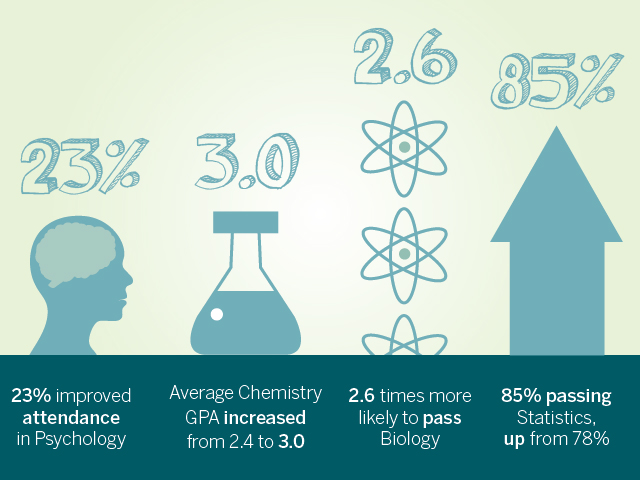More than 10,000 students each year take introductory courses in biology, chemistry, statistics and psychology at The University of Texas at Austin. Success in these large-enrollment courses can make or break a student’s entire college trajectory and eventual career path.
 The stakes are high, and historically a fifth of students have not been successful on their first attempt, often resulting in delayed graduation or a costly decision to change majors.
The stakes are high, and historically a fifth of students have not been successful on their first attempt, often resulting in delayed graduation or a costly decision to change majors.
The Course Transformation Program at the university is changing that. In the first year, transformed versions of theses courses have yielded higher grades, improved attendance and lower QDF (quit/drop/fail) rates. For example:
- Biology – First semester students were 2.6 times as likely to pass transformed courses as regular courses, after controlling for student and instructor factors.
- Chemistry – The average course GPA rose more than half a letter grade, from 2.4 to 3.0, compared with previous classes by the same instructors.
- Statistics – Fewer students dropping or failing the class, a decrease from 22 percent to 15 percent.
- Psychology – A 23 percent improvement on student attendance compared with the previous semester.
And this fall, the program is launching its next round of course transformations for English and economics.
“Most students who fail don’t fail because they don’t work hard or don’t have the capacity to learn,” said Gretchen Ritter, director of the program and vice provost for undergraduate education and faculty governance. “In the typical large, first-year lecture class, students often don't have a clear sense of how well they are doing until they get back their first exam — and by then it may be hard for them to adjust and be successful in the class.”
What do these courses have in common? A hybrid structure that uses the latest in educational technology and the best practices in teaching: robust in-class discussion, video modules to supplement readings, team teaching models and immediate student feedback.
The five-year initiative is a central element in President Bill Powers’ campaign to reinvent higher education for the 21st century.
If anything, these classes are more rigorous than the traditional lecture-style classes. Just ask the students. One of the students surveyed after her transformed biology class wrote:
“The value of it now, in hindsight, at the end of the semester — it totally transformed the way that I studied, the commitment I had to all my other classes, the ability to recognize what I didn’t know versus what I know — which is invaluable. I can say that now. But in the beginning, I was ready to walk out.”


















Comments